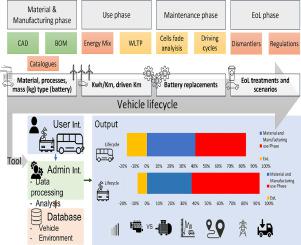当前位置:
X-MOL 学术
›
J. Ind. Inf. Integr.
›
论文详情
Our official English website, www.x-mol.net, welcomes your feedback! (Note: you will need to create a separate account there.)
Eco-design tool to support the design of industrial electric vehicles. The case studies of an electric shuttle and an autonomous mobile robot
Journal of Industrial Information Integration ( IF 15.7 ) Pub Date : 2024-03-21 , DOI: 10.1016/j.jii.2024.100605 Luca Manuguerra , Federica Cappelletti , Marta Rossi , Michele Germani
Journal of Industrial Information Integration ( IF 15.7 ) Pub Date : 2024-03-21 , DOI: 10.1016/j.jii.2024.100605 Luca Manuguerra , Federica Cappelletti , Marta Rossi , Michele Germani

|
The benefits of process optimization brought by multiple tools that appeared in shopfloors with the fourth industrial revolution are undiscussed; however, they need electricity to run and require critical materials. Additionally, the significant impact on sustainability that early design decisions can have over the entire lifecycle is well-recognized. The literature counts several environmental analyses of electric vehicles but narrows almost uniquely on passengers’ cars. Currently, the literature should i) enwiden the range of analyzed products, ii) consider all stages of the product life cycle, iii) provide tools suitable for the early stage of design, able to return consistent results handling very little data. As electrification is concerned, in the literature there are approaches intended to assess the environmental impacts or focused on the design tool. The proposed approach, further applied to develop an eco-design tool, overcomes the existing literature by providing a tool i) able to handle few data, ii) that considers all the product lifecycle phases, and iii) allows designers to assess and compare alternative scenarios. A method is proposed, and a tool derived. Two applications concern an electric shuttle and an autonomous mobile robot; with the latter the gap of assessing the environmental impact of autonomous mobile robots is also filled. The obtained results are reasonably comparable with other existing works. Results are compared to a full LCA for the frame assembly and prove that i) the tool is reliable, and it more likely overestimates the impacts; ii) the design phase is subjected to high variability, and this affects the tool results. Future works may introduce additional types of batteries, deeper focus on the manufacturing phase; machine learning techniques may support future extension of the tool and create parametric models for conceptual and early design. The proposed method and tool can be extended to the economic sphere.
中文翻译:

支持工业电动汽车设计的生态设计工具。电动班车和自主移动机器人的案例研究
第四次工业革命中出现在车间的多种工具所带来的流程优化的好处尚未被讨论;然而,它们需要电力来运行并需要关键材料。此外,早期设计决策对整个生命周期可能产生的可持续性的重大影响是众所周知的。文献对电动汽车进行了多项环境分析,但几乎只局限于乘用车。目前,文献应该i)扩大分析产品的范围,ii)考虑产品生命周期的所有阶段,iii)提供适合设计早期阶段的工具,能够处理很少的数据返回一致的结果。就电气化而言,文献中存在旨在评估环境影响或侧重于设计工具的方法。所提出的方法进一步应用于开发生态设计工具,通过提供一种工具来克服现有文献:i)能够处理少量数据,ii)考虑所有产品生命周期阶段,iii)允许设计者评估和比较替代方案场景。提出了一种方法,并衍生了一种工具。两个应用涉及电动班车和自主移动机器人;后者也填补了评估自主移动机器人对环境影响的空白。获得的结果与其他现有作品具有合理的可比性。将结果与框架组件的完整 LCA 进行比较,并证明 i) 该工具是可靠的,并且它更有可能高估了影响; ii) 设计阶段的可变性很高,这会影响工具结果。未来的工作可能会引入其他类型的电池,更深入地关注制造阶段;机器学习技术可以支持该工具的未来扩展,并为概念和早期设计创建参数模型。所提出的方法和工具可以扩展到经济领域。
更新日期:2024-03-21
中文翻译:

支持工业电动汽车设计的生态设计工具。电动班车和自主移动机器人的案例研究
第四次工业革命中出现在车间的多种工具所带来的流程优化的好处尚未被讨论;然而,它们需要电力来运行并需要关键材料。此外,早期设计决策对整个生命周期可能产生的可持续性的重大影响是众所周知的。文献对电动汽车进行了多项环境分析,但几乎只局限于乘用车。目前,文献应该i)扩大分析产品的范围,ii)考虑产品生命周期的所有阶段,iii)提供适合设计早期阶段的工具,能够处理很少的数据返回一致的结果。就电气化而言,文献中存在旨在评估环境影响或侧重于设计工具的方法。所提出的方法进一步应用于开发生态设计工具,通过提供一种工具来克服现有文献:i)能够处理少量数据,ii)考虑所有产品生命周期阶段,iii)允许设计者评估和比较替代方案场景。提出了一种方法,并衍生了一种工具。两个应用涉及电动班车和自主移动机器人;后者也填补了评估自主移动机器人对环境影响的空白。获得的结果与其他现有作品具有合理的可比性。将结果与框架组件的完整 LCA 进行比较,并证明 i) 该工具是可靠的,并且它更有可能高估了影响; ii) 设计阶段的可变性很高,这会影响工具结果。未来的工作可能会引入其他类型的电池,更深入地关注制造阶段;机器学习技术可以支持该工具的未来扩展,并为概念和早期设计创建参数模型。所提出的方法和工具可以扩展到经济领域。



























 京公网安备 11010802027423号
京公网安备 11010802027423号